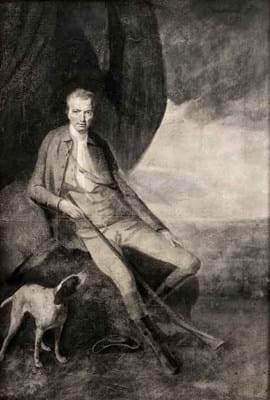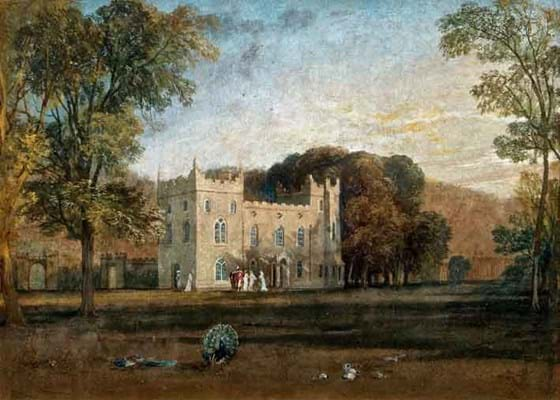Rarely seen on the market these days, the artist achieved considerable recognition in his day even though he never used colours - something which has led to the suggestion that he was colour-blind.
In spite of this, he received some notable commissions for his black and white portraits, including from Lord Mountjoy and the Conollys of Castletown in County Kildare. Today, two of his self-portraits can be found in the National Gallery of Ireland.
Also credited as a horse painter, he operated from a studio at Wood Quay in Dublin and exhibited his works at the Society of Artists in William Street where he was awarded a silver palette for the best exhibited drawing of a group of figures in 1770.
Having studied chalk and pastel at the Dublin Society Schools, he was clearly influenced by the portrait mezzotints of the day and, indeed, the soft techniques he adopted for these grisaille chalk portraits has been likened to the effects achieved through mezzotint prints by artists such as his Anglo-Irish contemporary Thomas Frye (c.1710-62).
Healy's full-length portraits generally depicted the subjects in a natural setting, as was the case with the pair at Adam's. Both were signed and dated 1769 and measured 23 x 16in (58 x 40cm).
Labels on the verso identified the sitter as Anthony Denny of County Kerry, although, since his dates did not fit in with the dates on the portrait, the auctioneers felt that the more likely candidate was his father, Sir Edward Denny of Tralee Castle and Churchill.
The fact that these pictures came with a provenance to the Beaulieu estate in Co Louth also suggested a member of the Denny family as the sitter. The Montgomery family who owned Beaulieu were connected to the Dennys via marriage.
Either way, the re-emergence of this pair were significant additions to Healy's known oeuvre and these may well have been the 'Small Whole Length Portraits' which were recorded as being exhibited by Healy at the Society of Artists in 1769.
In common with the medium, highlighted with bodycolour, both pictures had some condition issues - the depiction of the man sitting with a sporting gun and dog was in a notably worse state that its pair showing a man with a bench in a garden setting.
Estimated at £20,000-30,000, they drew competitive bidding and were knocked down at €42,000 (£37,170) to a private Irish buyer.
Although it is difficult to gauge the strength of this price, since the artist has only appeared at auction a handful of times in the last 20 years, it compared well with the result seen for another chalk drawing by Healy which sold at Christie's sale of items from Glin Castle in May 2009.
That work entitled Portrait of Miss Cunningham holding her King Charles spaniel had a seemingly more commercial subject and made £15,000.
Turner's 'Irish' Watercolour
The Adam's sale at Slane Castle, Co Meath on October 13-14 also offered J.M.W. Turner's (1775-1851) only known view of Ireland. The subject of the 13 x 17¾in (33 x 45cm) watercolour and bodycolour was Clontarf Castle, the coastal retreat of John Vernon (whose family had owned the estate since the time of Cromwell), located about two miles from Dublin city centre. It is now a hotel.
While Turner's topographical views and pictures of country houses are not that uncommon - they were in fact very much his stock-in-trade, especially in the earlier part of his career - what set this apart was not just the location but also the fact that no evidence exists that Turner ever went to Ireland.
The artist did have a connection to Clontarf, however, through Vernon's daughter, Maria Sophia, who became the second wife of Turner's patron and friend Walter Fawkes of Farnley Hall in 1816.
This picture, dated to c.1817, was therefore thought to be based on a sketch of the castle by another hand, possibly that of Maria Sophia Fawkes herself, who was a talented amateur artist. Could it have been that Turner painted this view as a reminder for the new Mrs Fawkes of her childhood home?
Clontarf Castle was built by the Knights Templar in the 12th century and the nearby Clontarf Church (which can be glimpsed in the far right corner of the work) was erected on the site of a monastery founded in 550AD. The present watercolour showed the castle before the additions undertaken by John Edward Venables Vernon with the architect William Vitruvius Morrison in 1836-7.
The depiction of the parkland setting with attractive autumnal colours, as well as the architectural details, was typical for Turner's earlier watercolours, but the peacocks, doves and young ladies conversing with an officer gave it an added narrative.
In general terms, these kind of views tend to rank behind his classical landscapes, marine scenes and later 'tumble-dryer' pictures in their commercial standing, but this work had an interesting academic element.
Until 1989, its existence was only known through a listing in Turner's Farnley Hall sketchbook where the artist had recorded watercolours he had drawn for Walter Fawkes. Although presumably kept by Fawkes and his wife, its whereabouts were unknown for much of its history until it was rediscovered 24 years ago.
Since then, it has been studied by scholars and exhibited at the National Gallery of Ireland. It has also changed hands at least once - it was offered at Sotheby's in London in April 1998 where it was knocked down to the Irish trade at £35,000.
Fifteen years later, it was estimated by Adam's at €20,000-40,000.
The Irish link didn't seem to spark the fireworks among collectors that might have been hoped for, but there were still around five or six interested parties who were keen on it, mostly from the UK, and bidding on the day rose to €65,000 (£57,525), when it was knocked down to a UK-based collector bidding online. The uplift in price across 15 years was not great but more than reasonable in the context of the generally lacklustre market for English watercolours.
The price appears in line with the result for a smaller watercolour entitled The Mouth of the Avon, near Bristol, seen from Cliffs below Clifton which sold at Tennants of Leyburn in March this year for £40,000. It is now owned by the Bristol Museum and Art Gallery.
The buyer's premium was 20%.










